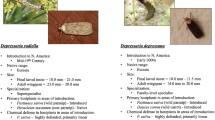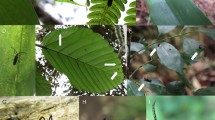Abstract
The pipevine swallowtail, Battus philenor, feeds exclusively on plants in the genus Aristolochia, many of which are known to contain the toxic alkaloids collectively known as aristolochic acids. Pipevine swallowtails sequester these compounds and use them for their own defense against predators. Numerous palatable butterflies are involved in Batesian mimicry complexes with B. philenor over its range. The California subspecies of the pipevine swallowtail, B. philenor hirsuta, has no mimics. Analysis of the butterfly and its only host plant, Aristolochia californica, indicate that both contain aristolochic acid. Aristolochic acid (I) and (II) are the primary aristolochic acids found in A. californica. The highest concentration of aristolochic acids was found in the flowers, which bloom before B. philenor emerges. Concentrations of aristolochic acids decreased in the leaves but not in stem tissue over the course of the season. Butterflies contained primarily aristolochic acid (I). Aristolochic acid content of individuals from Arizona, which are involved in mimicry complexes, did not differ from California populations. Thus, lack of California mimics cannot be attributed to low aristolochic acid content of the model.
Similar content being viewed by others
REFERENCES
Berenbaum, M. R., Zangerl, A. R., and Nitao, J. K. 1986. Constraints on chemical coevolution: Wild parsnips and the parsnip webworm. Evolution 40:1215–1228.
Brower, J. V. Z. 1958. Experimental studies of mimicry in some North American butterflies. Part II. Battus philenor and Papilio troilus, P. polyxenes and P. glaucus. Evolution 12:123–136.
Brower, J V. Z. 1960. Experimental studies of mimicry. IV. The reactions of starlings to different proportions of models and mimics. Am. Nat. 94:271–282.
Brower, L. P. 1984. Chemical defence in butterflies, pp. 109–134, in R. I. Vane-Wright and P. R. Ackery (eds.). The Biology of Butterflies. Academic Press, New York.
Brower, L. P., and Brower, J. V. Z. 1962. The relative abundance of model and mimic butterflies in natural populations of the Battus philenor mimicry complex. Ecology 43:154–158.
Brower, L. P., Alcock, J., and Brower, J. V. Z. 1971. Avian feeding behavior and the selective advantage of incipient mimicry, pp. 261–274, in R. Creed (ed.). Ecological Genetics and Evolution, Essays in Honour of E. B. Ford. Blackwell Scientific Publications, Oxford.
Brower, L. P., Seiber, J. N., Nelson, C. J., Lynch, S. P., and Tuskes, P. M. 1982. Plant-determined variation in the cardenolide content, thin-layer chromatography profiles, and emetic potency of monarch butterflies, Danaus plexippus, reared on the milkweed, Asclepias eriocarpa, in California. J. Chem. Ecol. 8:579–633.
Chen, Z. L., and Zhu, D. Y. 1987. Aristolochia alkaloids, pp. 29–65, in A. Brossi (ed.). The Alkaloids: Chemistry and Pharmacology. Academic Press, San Diego.
Clarke, C. A., and Sheppard, P. M. 1962. The genetics of the mimetic butterfly Papilio glaucus. Ecology 43:159–161.
Codella, S. G., Jr., and Lederhouse, R. C. 1989. Intersexual comparison of mimetic protection in the black swallowtail butterfly, Papilio polyxenes: Experiments with captive blue jay predators. Evolution 43:410–420.
Hagen, R. H., and Scriber, J. M. 1995. Sex chromosomes and speciation of swallowtail butterflies, pp. 211–227, in J. M. Scriber, Y. Tsubaki, and R. C. Lederhouse (eds.). Swallowtail Butterflies: Their Ecology and Evolutionary Biology. Scientific Publishers, Gainesville, Florida.
Hagen, R. H., Lederhouse, R. C., Bossart, J. K., and Scriber, J. M. 1991. Papilio canadensis and P. glaucus (Papilionidae) are distinct species. J. Lepid. Soc. 45:245–258.
Jeffords, M. R., Sternburg, J. G., and Waldbauer, G. P. 1979. Batesian mimicry: field demonstration of the survival value of pipevine swallowtail and monarch color patterns. Evolution 33:275–286.
Koch, P. B., Keys, D. N., Rocheleau, T., Aronstein, K., Blackburn, M. M., Carroll, S. B., and Ffrench-Constant, R. H. 1998. Regulation of dopa decarboxylase expression during colour pattern formation in wild-type and melanic tiger swallowtail butterflies. Development 125:2303–2313.
Macdougall, A., and Dawkins, M. S. 1998. Predator discrimination error and the benefits of Müllerian mimicry. Anim. Behav. 55:1281–1288.
Mappes, J., and Alatalo, R. V. 1997. Batesian mimicry and signal accuracy. Evolution 51:2050–2053.
Mckey, D. 1979. The distribution of secondary compounds within plants, pp. 56–133, in G. A. Rosenthal and D. H. Janzen (eds.). Herbivores: Their Interaction with Secondary Plant Metabolites, 1st ed. Academic Press, New York.
Moranz, R., and Brower, L. P. 1998. Geographic and temporal variation of cardenolide-based chemical defenses of queen butterfly (Danaus gilippus) in northern Florida. J. Chem. Ecol. 24:905–932.
Nishida, R., Weintraub, J. D., Feeny, P., and Fukami, H. 1993. Aristolochic acids from Thottea spp. (Aristolochiaceae) and the osmeterial secretions of Thottea feeding troidine swallowtail larvae (Papilionidae). J. Chem. Ecol. 19:1587–1594.
Odendaal, F. J., Rausher, M. D., Benrey, B., and Nunez-Farfan, J. 1987. Predation by Anolis lizards on Battus philenor raises questions about butterfly mimicry systems. J. Lepid. Soc. 41:141–144.
Platt, A. P., and Brower, L. P. 1968. Mimetic versus disruptive coloration in intergrading populations of Limenitis arthemis and Astyanax butterflies. Evolution 22:699–718.
Platt, A. P., Coppinger, R. P., and Brower, L. P. 1971. Demonstration of the selective advantage of mimetic Limenitis butterflies presented to caged avian predators. Evolution 5:692–701.
Poulton, E. B. 1909. Mimicry in butterflies of North America. Ann. Entomol. Soc. Am. 2:203–242.
Racheli, T., and Oliverio, M. 1993. Biogeographical patterns of the neotropical genus Battus Scopoli 1777 (Lepidoptera Papilionidae). Trop. Zool. 6:55–65.
Racheli, T., and Pariset, L. 1992. II genere Battus tassonomia e storia naturale. Fragm. Entomol. (Roma) (Suppl.) 23:1–163.
Rhoades, D. F. 1979. Evolution of plant chemical defense against herbivores, pp. 3–54, In G. A. Rosenthal and D. H. Janzen (eds.). Herbivores: The Interaction with Secondary Plant Metabolites. Academic Press, London.
Rhoades, D. F., and Cates, R. G. 1976. Toward a general theory of plant antiherbivore chemistry. Recent Adv. Phytochem. 10:168–213.
Ritland, D. B. 1994. Variation in palatability of queen butterflies (Danaus gilippus) and implications regarding mimicry. Ecology 75:732–746.
Rothschild, M., Reichstein, T., Von Euw, J., Aplin, R., and Harman, R. R. M. 1970. Toxic Lepidoptera. Toxicon 8:293–299.
Scriber, J. M., Hagen, R. H., and Lederhouse, R. C. 1996. Genetics of mimicry in the tiger swallowtail butterflies, Papilio glaucus and P. canadensis (Lepidoptera: Papilionidae). Evolution 50:222–236.
Shapiro, A. M. 1974. The butterfly fauna of the Sacramento Valley, California. J. Res. Lepid. 13:73–82, 115–122, 137–148.
Shapiro, A. M. 1984. Geographical ecology of the Sacramento Valley riparian butterfly fauna, pp. 934–941, in R. E. Warner and K. M. Hendrix (eds.). California Riparian Systems: Ecology, Conservation, and Productive Management. University of California Press, Berkeley.
Sims, S. R., and Shapiro, A. M. 1983. Seasonal phenology of Battus philenor (L.) (Papilionidae) in California. J. Lepid. Soc. 37:281–288.
Sperling, F. A., and Harrison, R. G. 1994. Mitochondrial DNA variation within and between species of the Papilio machaon group of swallowtail butterflies. Evolution 48:408–422.
Tsai, T.-H., Chou, C. J., Lin, L. C., Tsai, W. J., and Chen, C. F. 1993. Determination of aristolochic acid in rabbit plasma by high-performance liquid chromatography with photodiode-array ultraviolet detection and its pharmacokinetics application. J. Liq. Chromatogr. 16:1173–1182.
Turner, J. R. G. 1984. Mimicry: the palatability spectrum and its consequences, pp. 141–161, in R. I. Vane-Wright and P. R. Ackery (eds.). The Biology of Butterflies. Academic Press, New York.
Uesugi, K. 1996. The adaptive significance of batesian mimicry in the swallowtail butterfly, Papilio polytes (Insect, Papilionidae): Associative learning in a predator. Ethology 102:762–775.
UrzÚa, A., and Priestap, H. 1985. Aristolochic acids from Battus polydamas. Biochem. Syst. Ecol. 13:169–170.
UrzÚa, A., Rodriguez, R., and Cassesl, B. 1987. Fate of ingested aristolochic acids in Battus archidamus. Biochem. Syst. Ecol. 15:687–690.
Vane-Wright, R. I., Raheem, D. C., Cieslak, A., and Vogler, A. P. 1999. Evolution of the mimetic African swallowtail butterfly Papilio dardanus: Molecular data confirm relationships with P. phorcas and P. constantinus. Biol. J. Linn. Soc. 66:215–229.
Zangerl, A. R., and Bazzaz, F. A. 1992. Theory and pattern in plant defense allocation, pp. 363–391, in R. S. Fritz and E. L. Simms (eds.). Plant Resistance to Herbivores and Pathogens. Ecology, Evolution, and Genetics. The University of Chicago Press, Chicago.
Author information
Authors and Affiliations
Rights and permissions
About this article
Cite this article
Fordyce, J.A. A Model Without a Mimic: Aristolochic Acids from the California Pipevine Swallowtail, Battus philenor hirsuta, and Its Host Plant, Aristolochia californica. J Chem Ecol 26, 2567–2578 (2000). https://doi.org/10.1023/A:1005588829864
Issue Date:
DOI: https://doi.org/10.1023/A:1005588829864




